
“From the ashes of countless decayed Modernities comes Neo-Decadence, a profaned cathedral whose broken stained glass windows still glitter irregularly in the harsh light of a Symbolist sun. Behind this marvellously vandalised edifice, a motley band of revellers picnic in the graveyard of the Real, leaving behind all manner of rotting delicacies and toxic baubles in their wake. During the last eighty years, world culture has seen an explosion of popular aesthetics, art-forms and the movements associated with them: clothing, trends in fashion, tattoos, recreational drugs, musical sub-cultures, cosmetics, photography—all of which can be the subject of obsessions, damnations and salvations. Devices and formats, initially vulgar, are worshipped, only to be forgotten by all but the few initiates who, through their maniacal fixations, manage to uncover their hidden allure. These twelve stories and their preceding manifestos, then, arise from a shift in aesthetic consciousness: synaesthesia, ecstasy in extremes, the Divine and Infernal alike seen through a neurasthenic lens of supreme focus.”
-from the back cover of Drowning in Beauty
April 2018 marks the historic date of the release of Drowning in Beauty, the very first anthology devoted to the literary genre that has come to be known as Neo-Decadence. Edited by Daniel Corrick and Justin Isis, and published by Snuggly Books, the book contains 12 most unusual stories penned by a diverse range of writers from all walks of life. The purpose of this Day is to give the uninitiated a better idea of just what Neo-Decadence is (mainly via reposting the original Manifesto of Neo-Decadence as written by Brendan Connell, along with the second Manifesto that was written by Justin Isis), before focusing on the contributors of the collection and what their various influences and motivations were. It is hoped that this introductory Day will inspire the curious to seek out Drowning in Beauty and get their minds appropriately warped as a result. So, without further ado, let us begin where it all started: the Neo-Decadent Manifestos!
The First Manifesto of Neo-Decadence (Sunday, October 17th, 2010)
Brendan Connell
1. Words are only words, a somewhat artificial simulation of nature, and should not be given too much importance. Slick writing should be tossed out like men with sweaty hands, mass-produced objects, and food in Styrofoam cups.
2. Never imitate yourself. The writing should be artificial and shallow, without contrived emotions. Then maybe something will be realised. There is already enough sadness in life. Soak the book in gasoline if it must be soaked in something.
3. Character development is synthetic. It should be resorted to only with a certain amount of shame.
4. If it be political let it lurch to the left, burrow underground so that tall buildings tumble off their hinges.
5. Story arcs should only be used to hang oneself with. Nothing is ever resolved. Nothing progresses.
6. Syntax should be dredged out of old books, trimmed off of far-away planets, stripped from dreams. Trivial things should be said in a grandiose manner meant to disgust collegiate scribblers and make the lips of pseudo-great novelists twist in anger.
7. Kublai Khan was a modern. Things fell apart a long time ago. We are already living in the ruins of civilisation. There’s nothing to celebrate. When you toast, make sure you smash your glasses together. This kind of writing should be the same. Harmony is overrated.
8. Forget about the sound of cars, missiles, clever machines and originality, since nothing is less original. There are enough monsters and demons in the real world without needing to look elsewhere.
9. Great developments don’t come about by listlessly trying to please the crowd. They’ll forget in a minute. If the only thing left is a fragment, it better be good. If you’re lucky, you’ll end up like some choliambic poet.
10. There’s nothing wrong with writing a lousy book. Just make sure it’s really lousy. There is nothing worse than competence.
11. Neo-Decadent writers will honour the fragmented, the contorted, the unfinished, the unpublished. Realising there is no glory, no reward, no lavish suppers or dancing on tables. Living in obscure lanes and remote canyons, things will be written in unread languages or translated from the language of lizards and snakes, plagiarised from deep wells and signed with hands wet with the dew of rotting fruit.
12. Nothing comes to an end. Let a little light shine through the darkness and remember that when the universe collapses in on itself you can read the novel back to front.
Second Manifesto of Neo-Decadence (Tuesday, January 10th, 2017)
Justin Isis
1. A goat wanders at random, putting things in its mouth.
2. NO SUSTAINABILITY.
3. The kidneys are the prime organ of Neo-Decadence. The pink Gemini. Filtering. Most educated people have equally educated kidneys, which means they try to tell stories instead of pissing when needed. Keep an eye out for these creatures and their awards.
4. No precedence is given to the Decadent writers of the 19th century, their modes or milieu. Neo-Decadence is more likely to cross 1990s video game dialogue with the structure of a 16th century picaresque to discuss a drug deal in present day Mongolia. Fealty and earnestness can only hold back progress. We do not have saints, and we consume our idols.
5. Literature is not a guild system. Academies and workshops: a parade of inbred dogs with each generation more unfit than the last.
6. Writing can be neither sincere nor authentic; these are the clichés of the ranks of the dead. Style is a mute scream in symbols – that’s all.
7. There is nothing to learn, but much to steal.
* * * *
On November 17th, 2017, at the Thomas Ligotti Online forums, Justin Isis elaborated on the general lifestyle traits that Neo-Decadent writers share:
“1. Doing cocaine, amphetamines, acid and Hydrox cookies every week.
2. Being in better shape than you really need to be (more shredded than the majority of people around you) or in worse shape than you need to be (i.e. you walk to work every day and have access to healthy food but are still fat and eat at Wendy’s and Arby’s all the time).
3. Having sex with more than ten people a week.
4. Being able to name at least sixty clothing designers and having detailed opinions on them all.
5. Attending High Mass in Latin just to be hardcore, despite not technically ‘believing’ in anything.
6. Having no children, or having more than five.
7. Spitting in the street every time an academic or anyone who has attended a ‘Writing Workshop’ walks by.
If you overheard people talking at two different tables and simultaneously heard them making the following statements:
‘Global warming doesn’t have anything to do with people, the planet is just warming up naturally.’
‘UNIQLO makes clothes that are cheap and easy to wear, I like their ‘normcore’ style.’
If you instinctively felt the urge to throw your drink at the person defending Uniqlo rather than the climate change denier, you’re probably Neo-Decadent. Your rational mind might then be like ‘Climate change deniers are a bigger problem than fast fashion,’ but the important thing is the initial impulse.”
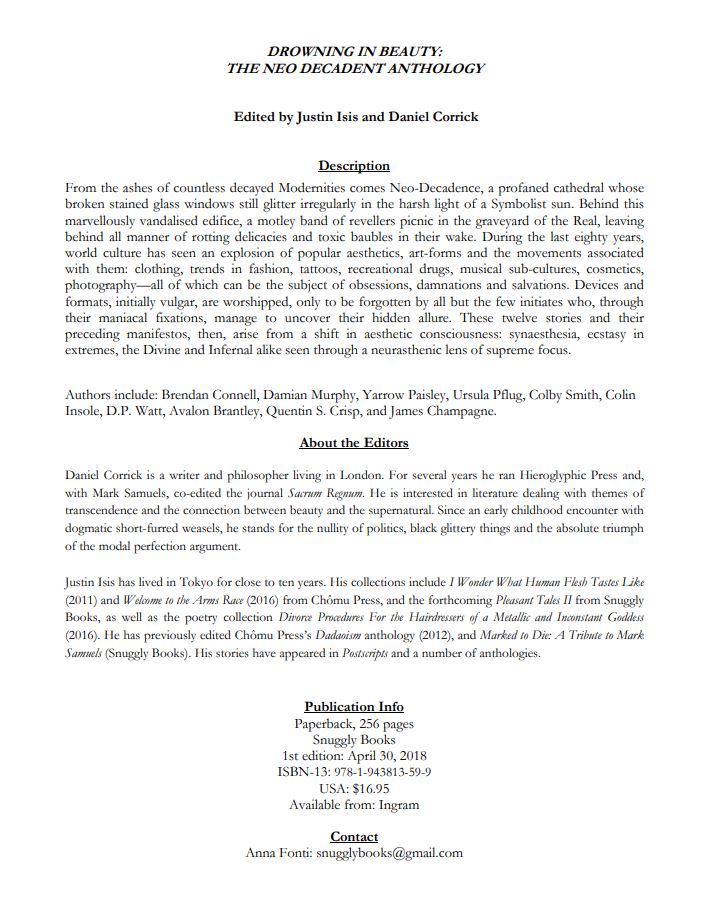
(Caption: The Drowning in Beauty Press Release)
The Neo-Decadent Video
Delivered at the Friends of the Library Room at Alden Library, Ohio University, Athens Campus by Drowning in Beauty contributor Colby Smith, with a Skype Skype appearance by editor/contributor Justin Isis. Shot and edited by Dani Wasserman. 1/29/2018
THE MANIFESTO OF NEO-DECADENT ACTIVISM (March 2017)
Colby Smith
1. Assume no sarcasm.
2. Deletion of encrypted messaging apps is vital for progress in networking. Substitute these with cassette recordings of feminist spoken word poetry read in black metal vocals.
3. Consume everything and be confined to your armchair or consume nothing and never sit in an armchair in your life. There is no middle-ground.
4. Wokeness is synonymous with kvltness; nobody is kvlt except yourself, because the gut is the temple of the body.
5. Devise your rhetoric at random, discarding all previous notions on a whim. Become an ideological chameleon.
6. Find allies in flat-earthers, creationists, anti-vaxxers, etc. Facts are the spit of the shoe-shine boys of the elite.
7. Poison the wells with chai lattes and DMT.
8. Around your parents, become as offensive as a skunk; around your comrades, become as inoffensive as a church mouse.
9. Silver-pacifism is nice but violence is golden. Language is the most potent weapon, for want of the courage to serve serious time.
To Purchase
Drowning in Beauty may be purchased at any of the following links:
Snuggly Books: http://www.snugglybooks.co.uk/drowning-in-beauty/
Barnes & Noble: https://www.barnesandnoble.com/w/drowning-in-beauty-justin-isis/1127576612?ean=9781943813599
Amazon: https://www.amazon.com/Drowning-Beauty-Neo-Decadent-Justin-Isis/dp/1943813590
The Contributors
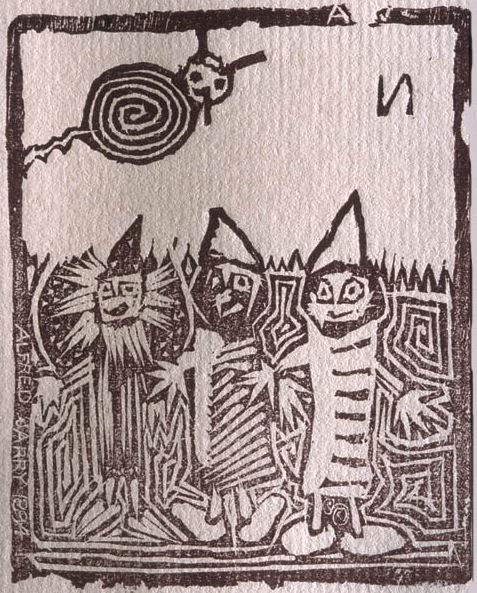
Brendan Connell: “Molten Rage”
Brendan Connell was born in Santa Fe, New Mexico, in 1970. He has had fiction published in numerous places, including McSweeney’s, Adbusters, and the World Fantasy Award winning anthologies Leviathan 3 (The Ministry of Whimsy 2002), and Strange Tales (Tartarus Press 2003). His published books are: The Translation of Father Torturo (Prime Books, 2005), Dr. Black and the Guerrillia (Grafitisk Press, 2005), Metrophilias (Better Non Sequitur, 2010), Unpleasant Tales (Eibonvale Press, 2010), The Life of Polycrates and Other Stories for Antiquated Children (Chomu Press, 2011), The Architect (PS Publishing, 2012), Lives of Notorious Cooks (Chomu Press, 2012), Miss Homicide Plays the Flute (Eibonvale Press, 2013), The Cutest Girl in Class (Snuggly Books, 2013), The Galaxy Club (Chomu Press, 2014), The Metanatural Adventures of Dr. Black (PS Publishing, 2014), Cannibals of West Papua (Zagava, 2015), Jottings from a Far Away Place (Snuggly Books, 2015) Clark (Snuggly Books, 2015), and The Heel (Snuggly Books, 2017).
Eleven views of Neo-Decadents: Some extracts from the books of Brendan Connell
1. From “The Despoiler”; originally published in 2000; reprinted as “Vancouver” in Metrophilias in 2010
He remembered her, that head of long black hair; dark as iron oxide, or the soil of mars. Yes, her body might very well have been repulsive; and that face, as a skull might look bound in soiled linen. But what did it matter? Fibres, tendrils, gossamer. . . . The veins ran along his white wrists and quickened the flow of that thin, blue liquid.
2. From The Translation of Father Torturo, Prime, 2005
He fingered his rosary, turned to the right, crossed in front of the High Altar, stopped and looked: There was another Jesus; the Jesus Christ of Donatello, cast in black bronze, emaciated, suffering—dying the death of the righteous. The angels danced at his pierced feet, sung and played on harps and flutes. There were the panels depicting the miracles of Saint Anthony, which, as incredible in detail and craftsmanship as they were (profound in their beauty), inspired nothing in the priest but rancour, a feeling of ill will, as if his due rights, his fortune, had been unjustly snatched from him and cast to the paws of the lazy, sensual crowd: those hundreds of thousands who came each year, dined amply on baccala alla Padovana, and then, bellies distended with feed, came and set their gazes and greasy palms on the trophies—the bones that might have been his very own for all he had suffered, laboured in the cause of the Law and been spat upon with the trifling matters of cheesemongers’ wives.
3. From Dr. Black and the Guerrillia, Grafitisk Press, 2005
That evening: a young woman wearing a banana-leaf bra and a grass skirt dyed bright crimson with the juice of the achiote berry as well as a garter of parrot down around her knee signifying her virginity served the doctor boiled muscovy duck and air potatoes seasoned with aji. He slept in a hut thatched with fronds of the cohune palm and could hear the coquí (tree frogs) sing. In the days that followed: He taught Quispe how to tie a Matthew Walker knot, while the young man in turn demonstrated how to make that velvet-black juice called curare from the barks of Strychnos toxifera and Chondrodendron tomentosum, and then the fish poisons: timiu and masu, as well as elaborate traps for birds. The doctor took notes of the daily habits of the tribe, indulged himself in anthropological recreations, gravely watched the women prepare yucca and their local beverage: a drink made from peach palm fruit (Bactrix gasipaes); them giggling under the glint of his eyes; certain maidens, slim grasshoppers, sending his way dazzling ultratropical smiles. He composed a brief vocabulary of the Yaroa language, heavy in frictionless continuants and flapped palato-alveolar consonants, as well as ingressive, implosive speech sounds produced by suction occlusion and plosive release, which facilitated him in basic communication with the tribespeople.
4. From Metrophilias, Better Non Sequitur, 2010
“Xi’an”:
It was around 5:00 p.m. on a hot summer day. The ¬police, having received a report of indecency, burst into the apartment of Yao Fa, a thirty-nine year old postal worker, who lived on Jinhualu. They found him wearing a curly mid-length blonde synthetic wig. Aside from that, he was completely naked. Upon searching the apartment, they discovered numerous other wigs, of every make and description. Over three hundred of them were counted. Mr. Yao was arrested. Later, upon being questioned, he said that he found great pleasure in putting on wigs and looking at himself in the mirror. No further explanation of his behaviour was given.
5. From Unpleasant Tales, Eibonvale Press, 2010
Willi gazed at all this with increasing interest, now examining one item, now another. He tested the tone of a variety of Egyptian violoncello called a kemangeh-a’gouz, tried to make out the inscription of a set of panpipes from the Solomon Islands, caressed the nipple of a Javanese gamelan gong.
“And what is this?” he asked, pointing to an object which hung from the wall, the white and graceful neck of a swan, its open billed head crowning one end.
“That my young friend is a swan’s horn,” Martens replied, with an obvious note of pride. “It is my own invention—one I made keeping in mind only the most hardened laws of science.”
“Is it real?—I mean, it really does look like an actual swan!”
“It is an actual swan. The head and neck and a bit of the breast of an actual swan, preserved, even somewhat beautified, with glass-like enamel.” He reached up and took it down from the wall. “The unusual conformation of the wind pipe, or vocal chord, of the bird makes it ideal to be transformed into a horn. These properties were first observed by Aldrovandus, though, due to today’s rather lame level of education I cannot expect you to have heard of the man. In any case, the length of the swan’s neck far exceeds that of its gullet. It has also in its chest a sinuous revolution; that is, when wind rises from its lungs, it ascends not directly into the throat, but first descends into the capsulary receptacle of the breast bone; by a serpentine recurvation it ascends again into the neck; and so by the length thereof a musical modulation is effected. As you can see, I have had to add a few accoutrements, but what I have added does for the most part follow the birds natural structure, though my creation here is of course better formed for music.”
So saying, he put his lips to a mouthpiece fitted to the lower end of the object and began to play. The sound was incredibly strange, superbly sweet. Martens stood with his legs slightly apart, eyes closed, a look of supreme concentration on his face as he blew forth wind into the outlandish instrument he had created. Music filled the room, issued from the bill of that long-necked water-bird, almost melancholic, thoroughly mystical, great cries of angst interwoven with splinters of pitch, exceedingly sharp, as precious as diamonds. Feathery high notes flew up, seemed to melt in the air, were suddenly juxtaposed with resonating bass, klaxons of most thrilling, almost impudent flourish. The hair on the back of Willi’s neck stood on end. He felt as if transported into some crepuscular place, a region where things might happen outside the physical laws of the universe. The complex orgy of intonations that poured forth from that twisted white neck thoroughly affected his nature, one which was rather absurdly sensitive to the grace of fine music.
6. From The Life of Polycrates and Other Stories for Antiquated Children, Chomu Press, 2012
“This afternoon,” Pison said, “while going for a stroll, I saw a man digging his field, and the very sight made me feel as if all my bones were broken.”
“Well,” Syloson replied, languidly fingering a Phibalean fig, “just your telling me this story makes me feel as if an ox were standing on my shoulder.”
“Which one?”
“Oh, I am uncertain. . . . Maybe the left.”
“Are you sweating?”
Syloson bit into the fig, and chewing replied, “Possibly . . . if you see perspiration glistening my upper lip.”
Pison’s face assumed a look of great concern, almost panic and, without losing time, he cupped his hands around his mouth like a horn and shouted, “Iops, Zetes, come out you dirty slaves! Your master’s lip is exhausted from labour, his person demands the breath of cooling fans of feathers!”
Immediately there was heard from without the hurried sound of sandals coursing over handsomely tiled halls, and a moment later two anxious slaves presented themselves, each carrying an enormous fan of oil-of-civet-scented ostrich feathers. Iops fanned Syloson while Zetes, a lad with dreamy eyes, fanned Pison.
“But tell me, will your chef be serving fried caviar today?”
“Pison, you are surely the slimmest of pigs.”
7. From The Architect, PS Publishing, 2012
Through a sort of mass hypnotism, all obeyed him who was referred to as Brother XII blindly. He had a private cook, a man from Bavaria, who was able to work miracles with a saucepan and prepared him liver of burbot and omelets of ambergris, partridges stuffed with frankincense and batter-fried eel larvae. Designated colony females, married or single, were to mate with Brother XII up to nine times, and roll with him on beds of verbena—an activity which Maria herself fully approved of, convinced as she was of the architect’s saintly qualities. And indeed his spectacular vices had something grand about them—something truly supramundane which recalled those ancient Roman emperors who claimed themselves to be descendants of gods and spat upon morality and temperance alike as with drunken laughter they set men aflame, dined off the naked backs of prostitutes and demanded obedience from both moon and sun, shoving stars into the facial orifices of their lovers while reciting long and dreary poems that put their page boys to sleep.
8. From Miss Homicide Plays the Flute, Eibonvale Press, 2013
Red magic liber sacer de novem candariis cream of occult sciences books ascribed to Solomon hairs of menstrous woman put under dung breed serpents images of gods may be summoned by the stone called Anchitis ghosts of the dead may be kept up by the stone Synochitis tremble fanatic fantastic twitch.
9. From The Metanatural Adventures of Dr. Black, PS Publishing, 2014
The décor was marvellous; a veritable forest of scientific instruments. Beakers. Glass tubes. Odd machinery. Hygrometers and hydrostatical glass bubbles. Saccharometer. A large, French, grain testing balance. A hand-driven ciphering machine. Capillary tubes. Optical goniometer. An enormous worm floated in formaldehyde.
“In this place I can make anything I want. Tools to both help and hinder mankind, as my fancy dictates. Delicate poisons—marvellous cures—machines to perform sundry bizarre tasks both practical and useless. With my compounds,” he waved his hand towards a wall completely covered with racks containing jars of chemicals, a dazzling rainbow of colours: sulphurous yellows, violent greens, dazzling sun-set oranges, “I have all nature at my disposal. I can synthesize anything, from a simple mammalian protein, to a flower.”
10. From The Cutest Girl in Class, Snuggly Books, 2013 (written in conjunction with Quentin S. Crisp and Justin Isis)
“My name’s Carl French,” he said.
“So.”
“You might have heard of me.”
“I never heard of you.”
“I’m a sculptor. I do the human figure—and baby, you got a figure!”
Noel Toy turned around.
“This your pick-up line?” she asked.
“No. I am making a sculpture of Venus. In immortal bronze.”
Toy lit a Pall Mall cigarette. She was listening.
“Yes, I am making a statue of the great goddess Venus and—can I be frank with you, Miss Toy?”
“You can be anyone you want to be.”
“Well, to be frank with you, you have a little bit of Venus between your legs.”
“Between my what?”
“Your legs, Miss Toy. Your, how shall I put it—your VAGINA is that of my Venus.”
“Boy, you crazy!”
11. From Cannibals of West Papua, Zagava, 2015
And beneath the wings of her shelter the two bodies absorbed the dirt. They gnawed at each other’s ears like soldiers with their arms cut off, desperate to inflict damage with their tongues and teeth in tameless chivalry. The priest, who had been, as was proper, a virgin of sorts, lost himself in her florid spasms, which were like the blue juice of shadows bleeding at dawn. The restraint he had attempted to practice from his youth was swept away like a twig in a rapid river, and the instinct of lust, like the instinct for survival, for murder, made him wriggle and quake with convulsive pleasure.
Justin Isis: “The Quest for Nail Art”

Justin Isis has lived in Tokyo for close to ten years. His collections include I Wonder What Human Flesh Tastes Like (2011) and Welcome to the Arms Race (2015) from Chômu Press, and the forthcoming Pleasant Tales II from Snuggly Books, as well as the poetry collection Divorce Procedures For the Hairdressers of a Metallic and Inconstant Goddess (2016). He has previously edited Chômu Press’s Dadaoism anthology (2012), and Marked to Die: A Tribute to Mark Samuels (2016). His stories have appeared in Postscripts and a number of anthologies, such as The Master in Cafe Morphine (2010) and Wound of Wounds (2017) from the Mount Abraxas imprint of Ex Occidente Press. His interests include hip-hop, bandes dessinées, Situationism, ritual magick and various tryptamines. His upcoming novel is called Invariant.
“The Quest for Nail Art” is a post-Naturalist presentation of Kabukicho’s psychic image-repertoire, fixating primarily on its hostess and Girls Bar cultures and refracting them through the prism of contemporary Japanese nail designs. Extensive research was conducted over a period of years, consisting of numerous interviews with salon technicians in Tokyo and endless nights spent roaming the streets of Shinjuku. The story is an excerpt from a larger forthcoming work, a kind of Cubist novel focusing on the psychogeography of gyaru culture over the past twenty years.
STORY EXTRACT: She went to her bureau and returned with various issues of Nail Max and Nail Venus. Flipping through the brightly-colored pages, she found little that met her approval – only the same absence of inspiration afflicting the nail salons of Shinjuku, Shibuya and Ikebukuro. As a teenager Rumika, like most of her friends, had fallen under the influence of the Carry Salon, with its extravagant designs and Egg model clientele, changing her nails to reflect any passing interest, requesting pierced acrylic nails with dangling chains and rings; pointed gel nails with gold and silver foils, water decals and butterfly stencils; leopard, zebra and dalmatian-patterned nails with tiny hearts and stars; transparent oval nails with galaxies of glitter dusting their crystal finish; square-cut nails with teardrop jewels and flower gems forming tiny opalescent gardens; and water-marbled nails with orange and green swirls like neon cream in psychedelic coffee. But now these designs had lost their novelty, and Carry bored her as much as the high-end salons in Roppongi and Azabu-Juban. First in her mental inventory of errors were themed nails: Minnie Mouse accessories atop Disney castle decals, or miniature Christmas ornaments on red and green base coats; next was the other extreme, nails with no coherent order, only a riot of competing decorations: rings of rainbow beads and pearls encircling Swarovski crystals, or inset panels with poems traced in lacquered letters; finally there were nails too unexceptional to merit attention, the cheap painted press-ons and French-tipped clichés marring the hands of schoolgirls and indifferent office workers. Rumika had not fallen to these depths in years, but neither had she perfectly upheld her own standards: her current nails were cute and certainly inoffensive, but not super cute in a definitive way that would place them beyond criticism.
Various images including Shizuka Muto, founder of the Rady brand:















Nail Tutorial
Nail Tutorial
Nail Tutorial
Girl’s Life: Rina Sakurai
Sifow: Carat PV
Tsubasa Masuwaka: Magic to Love PV
Damian Murphy: “A Mansion of Sapphire”
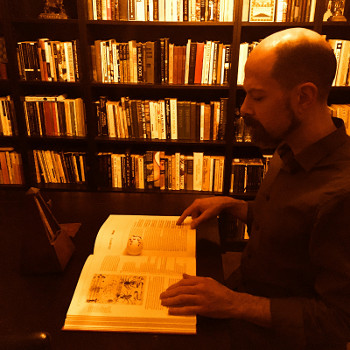
Damian Murphy is the author of Daughters of Apostasy, The Imperishable Sacraments, Seduction of the Golden Pheasant, and Abyssinia, among other collections and novellas. His work has been published on the Mount Abraxas, Les Éditions de L’Oubli, and L’Homme Récent imprints of Ex Occidente Press in Bucharest, by Snuggly Books in the UK, and by Zagava Books in Dusseldorf. He was born and lives in Seattle, Washington.
“A Mansion of Sapphire” follows a woman into the throes of a harrowing obsession with her ZX Spectrum gaming machine. She passes through the houses of delirium and religious ecstasy as the perilous secrets of the crown jewel of her collection are gradually unveiled.
STORY EXTRACT: She passed through lavish parlors and elaborate boudoirs as the crimson rays of jeweled chandeliers washed over and through her like a scintillating tide. An upraised hand of delicate crystal was found upon a torch-lit stage. A ruby placed into a niche within its palm gave passage to a catwalk drenched in shadow. She ascended an ivory stairway into a powder room of coral and alabaster, its intricate ornamentation bathed in the shimmering light of two candelabras. A cut glass washbowl, half-filled with water, resided on a decorative stand. Below, on a narrow shelf of rich, dark wood, was found a modest collection of patens, ciboria, censers, and communion cups, all arranged around an elaborate monstrance topped with the supremacy of the cross.
Main influences for “A Mansion of Sapphire”:
La Mulana
http://store.steampowered.com/app/230700/LaMulana/
The Mojon Twins
http://www.mojontwins.com/
Luc Ferrari – Danses Organiques
https://www.youtube.com/watch?v=El2rmcFaHEw
Pierre Schaeffer – Le Trièdre Fertile
https://www.youtube.com/watch?v=TuPrxhR1vKY
Nick Montfort, Ian Bogost – Racing the Beam
https://mitpress.mit.edu/books/racing-beam
Teresa of Avila – The Interior Castle
http://www.sacred-texts.com/chr/tic/index.htm
The Pistis Sophia
http://gnosis.org/library/pistis-sophia/index.htm
Stella: The Atari 2600 VCS Emulator
https://stella-emu.github.io/
ZX Spectrum Maps Direct
https://www.zx-spectrum.cz/maps-direct.php
Remedios Varo – Mimesis
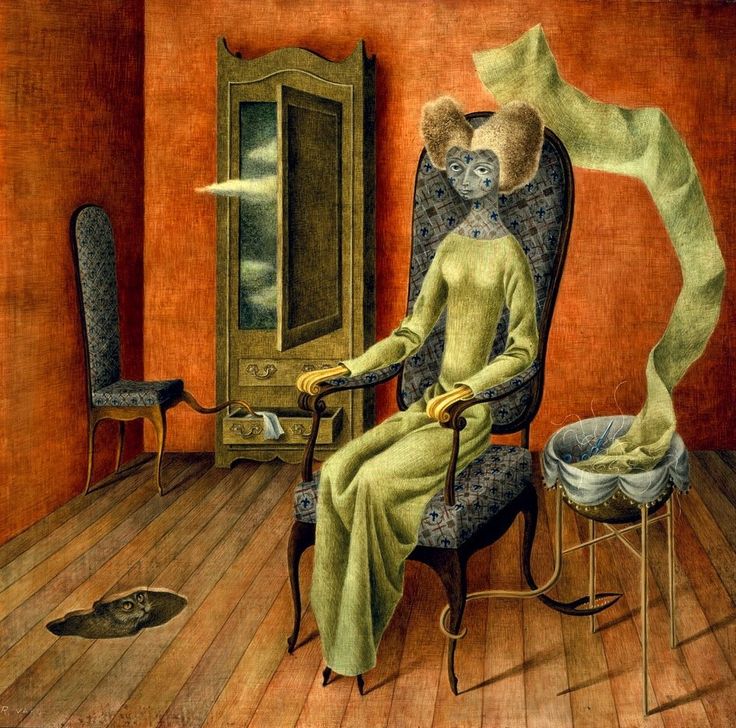
Remedios Varo – The Call
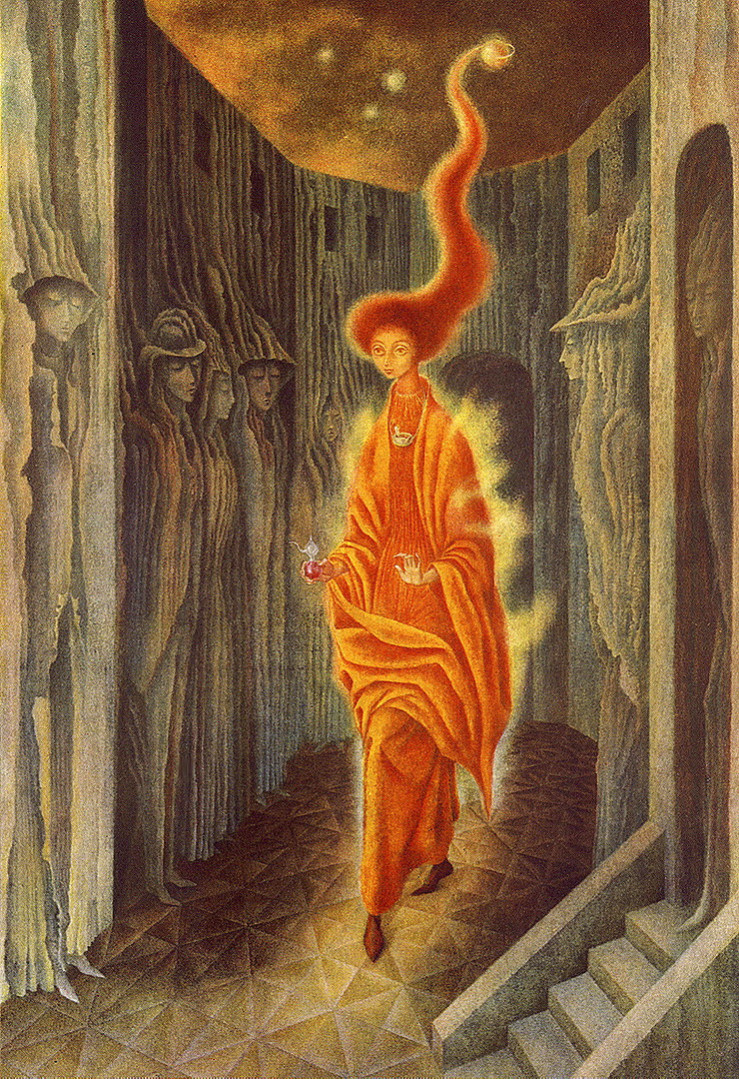
Yarrow Paisley: “Arnold of Our Time”

Yarrow Paisley
ypaisley@gmail.com
BIO
Yarrow Paisley is the author of I, No Other (Whiskey Tit) and Mendicant City (Snuggly Books). His writing has appeared in a number of anthologies, including Marked to Die (Snuggly Books), Dadaoism (Chômu Press), and Strange Tales V (Tartarus Press). He lives in Western Massachusetts.
ORIGINS
What inspired “Arnold of Our Time”? Whoo boy! There are at least a few explanations . . . requiring mental excavations on my part (represented in this text by ellipses). The exquisite primal essence of Arnold was spurted into being by a simple exercise of bouncing off another writer’s story like a trampoline . . . let me recall it, or rather, maybe I’ll delve into the records if there are any . . . this was years ago, mind you . . . hmm, failure, but I’m pretty sure it was a Ducornet (as I only did this exercise twice and I’d swear they were both from Ducornets).
Here’s what: I made a list: the first word of each sentence in the Ducornet. The exercise: sprout a story of my own, each sentence beginning with those particular words in that particular order. I changed proper names, of course, choosing “Arnold” and “Grand Ma Ma.” Lotsa fun was had! And a little piece of something called “Arnold Wears the Jersey” was produced. I liked the precious thing, which was cute with bunny ears and a wriggly nose, and edited it a bit without any more regard for the composing rule, but it seemed . . . not fucking enough. I tried to tell myself it was ENOUGH because I’m so lazy (comes down to parenting, doesn’t it), but we all knew it in our bones that there had to be more Arnold if it was to be a proper experience. So let’s set you aside for now, eh?
Suddenly, years had passed! I realized the solution was Episodes. This notion was inspired by Cortázar, believe it or not. I somehow suctioned up a cute li’l book at a library sale called A Certain Lucas, which was a congeries of brief episodes, and I instantly saw the Arnold connection. Of course! Episodes! From different angles! Multiple facets each channeling our gaze into the same diamond’s core. The diamond? Arnold, of course.
So I summoned my energies (using no rules this time) and out popped at least a couple of real cuties. Maybe three? (Yeah, three, cuz there’s five in all.) Loved them to bits! But it wasn’t enough . . . and I’d run out of steam again . . . Hmm, what was needed? Well, I knew what was needed. Another anchor. A showstopper! See, the three offshoots were gorgeous but slight. They garnished “Arnold Wears the Jersey,” they prettied him up . . . but this particular aggregation didn’t have . . . call it the grandiosity? . . . the scope? . . . that we were looking for . . . that we are forever looking for. Gravity? Yeah, this story needed to sink under the waves of the reader’s consciousness and cozy in under a reef and lurk with potential for reemergence in dreams or unctuous reveries. Another anchor would totally do the trick. I knew that, but I didn’t have the literary juice-flow to squeeze it out. So that brooded ‘pon its lonely mound in my computer’s backyard for a while. I shrugged it off, what can I say? Fucking lazy.
But what do you think happened? An unspecified time later? Justin Isis comes along! He asked me nicely for a story for his Neo-Decadant thing, and I really didn’t know what that was, truth be told, even finding Brendan’s manifesto online, still clueless (I’m a teensy bit brain cell deficient due to underuse), but I had a strong feeling that Arnold might’ve been ahead of his time . . . but now his time had come! So I called the whole beast “Arnold of Our Time” and proceeded to finish that motherfucker up! I suddenly knew exactly how the second anchor had to go, and so I made it go, yo.
STORY EXTRACT: ARNOLD PROPOSES AN ALTERNATIVE
Arnold contemplated the view through his bedroom window from time to time, supposing to himself that should a window have been situated just across, all these years, rather than a brick wall, in which Flirty Girl, for example, or perhaps even Giggly Slut, might occasionally have undressed her luscious body as it assumed a variety of imaginative and stimulative poses—unknowingly, yet also calculatedly, for his blissful benefit—then he would have passed a much happier and more fruitful adolescence.
In fact, theory did not preclude the possibility that the feminine gaze of his fenestral counterpart could in turn have studied his form with cognate carnal designs along the same eyeline; indeed, at times, perhaps their eyes would have crossed paths somewhere between the panes, midway, here or there, floating, circling each other shyly, buoyed up on shimmery clouds of Innocence, emboldening each other by the gentle acclimation of Desire simply to let go . . . yes, to fall . . . to fall in Love . . . and thus in Romance catch each other up from the hard landing of Perdition.
Everything is regret.
All hope—for the lack of a single window—had been lost to him:
Flirty Girl, it was well known, had been subdued by Heedless Jock; now she was known as La Belle Dame Sans Merci. Already, they owned a house together. Heedless Jock cheerfully manicured the graves in their backyard after his early-morning shifts at the Blight Insurance Agency.
Giggly Slut had relocated to NYC after high school and changed her name to Hipster Delite; she wore a red knit hat and a thin necktie on Social Media. Her firm yet waggly tongue tip and her bobbling cleavage were treasures now only to be appreciated in pixel renditions.
Grand Ma Ma alone timelessly perdured, bright star that she was.
LINKS
You know, it just occurred to me that a forerunner of Arnold was Bug Catcher, which was a movie I made years ago with my dad and little brother. I had encountered a full-sized VHS camcorder in a Salvation Army, you see . . . this thing was 20 years old, a VHS in the age of DVDs (but before streaming). I was enthralled with the idea of making a movie, and since these fellas would soon be visiting, I wrangled them into it. I wrote a script and made a list of shots I would need to get, and so we strapped my chair to the roof of my car and headed down to the park and got them . . . and afterward, I spent a good week editing the footage on my computer. I even made my own music for it! Of course, nowadays, everyone does this sort of thing with their iphones, so it’s not very impressive anymore. But back then! It was!! To me and mine, anyway. But here’s a link to Bug Catcher, and you may perceive in its tone and content, as I do, precognitive echoes of Arnold.
Aha! Scrounging around at that site a little more, I remembered Whistling in the Park, another video I did around that time. My dad and his girlfriend were in it this time. A shorter one, and there’s a nice twist at the end if you hang around for the whole thing.
Ursula Pflug: “Fires Halfway”

Ursula Pflug is author of the novels Green Music, The Alphabet Stones, Motion Sickness (a flash novel illustrated by SK Dyment); the YA novella Mountain and the story collections After the Fires and Harvesting the Moon. She edited the anthologies They Have To Take You In (a fundraiser for mental health) and Playground of Lost Toys (with Colleen Anderson) and has recently edited a new anthology, The Food of My People, with Candas Jane Dorsey. Her fiction, reviews and essays have appeared in Canada, the US and the UK, in Lightspeed, Fantasy, Strange Horizons, Postscripts, Leviathan, LCRW, Now Magazine, Bamboo Ridge, Back Brain Recluse, The New York Review of Science Fiction and elsewhere. Her books have been endorsed by Tim Wynne-Jones, Candas Jane Dorsey, Charles De Lint, Matthew Cheney, Leanne Betasamosake Simpson, Heather Spears, Jeff VanderMeer and others. Her award winning short stories have been taught at universities in Canada and India, and she has collaborated extensively with filmmakers, playwrights, coreographers and installation artists. Spring 2018 will see the release of a new novella, Down From, also from Snuggly.
* * * *
Justin Isis suggested we include music in our list of references.
My grandfather sang “Lili Marleen” to me on that trip, and told me the story of how it was the last thing played on Radio Belgrade every night, and was beloved by both sides. I like the Dietrich version more than the Lale Andersen:
I found a duet of “Lili Marleen” by Nina Hagen and Nana Mouskouri, but I want you to think well of the mother of punk, and it’s execrable. Still, you can look at it for historical interest, which it indeed has.
1980:
https://myspace.com/ninahagenrocks/music/song/ziggy-stardust-27672944-27474129
Before I left for Berlin my talented, ill-fated friend and I had toyed with the concept of a twinned, mirrored aspect to consciousness. The divided winter city, landlocked in communist Germany, with its towers and wall separating one side from the other became a kind of coded metaphor.
Listening to Nina covering “Lili Marleen” and the Brecht/Hauptmann/Weill collaboration “Alabama,” I thought of how a cover is a kind of time travel, but also something more. When we listen to Hagen sing a Weimar or WWII anthem, she casts light not just on those periods but on the pre-Wende music scene in West Berlin. We gain insight into multiple time periods in a way that we wouldn’t if we were visiting them discretely, listening only to originals anchored in the time of the song’s creation.
Nina, it turns out, is still performing. On March 14 2018 in Berlin, she sings Brecht lieder at the Museum für Kommunikation.
https://www.facebook.com/NinaHagen/photos/a.10150668177641523.397199.10100331522/10152063111086523/?type=3&theater
In a way, Hagen is the soundtrack to “Fires Halfway,” more than Bowie or Lou Reed, though Reed is the one I mention. Bowie, Reed and Hagen reprised the permissive glamour of the Weimar period, but Hagen, in spite of the unneveness of her work, did so with the most legitimacy.
After all, she is the one from the other side.
2015:
1977:
http://www.ursulapflug.ca/author-photo-neo-decadent-day-blog/
Marcus Bullock, Emeritus Professor of English at University of Wisconsin–Milwaukee, tells us “Remarkable for the way it emerged from a catastrophe, more remarkable for the way it vanished into a still greater catastrophe, the world of Weimar represents modernism in its most vivid manifestation.” The culture of the Weimar years was later reprised by the left-wing intellectuals of the 1960s especially in France. Deleuze, Guattari and Foucault reprised Wilhelm Reich; Derrida reprised Husserl and Heidegger; Guy Debord and the Situationist International reprised the subversive-revolutionary culture.
https://en.wikipedia.org/wiki/Weimar_culture
Brecht’s agitprop theatre was intended, he said, to wake people up. I often wonder what my grandmother would have to say about the current rise of white supremacy on both sides of The Big Pond. How to wake?
Matthew Surridge suggested that in my short stories I imbue my cities with more personality than my characters. If that’s the case, the main character in “Fires Halfway” may not be Kim but Berlin.
I keep going back, and I keep writing about her.
#
Toronto filmmaker Carol McBride directed this 1986 35mm film inspired by my first published short story, “Memory Lapse at the Waterfront.” The early 80’s were a fertile time for me. The story, which appeared in 1981’s Emanation Press anthology New Bodies, was reprinted in 2008’s After the Fires. Timely but unplanned, McBride digitized the original the year ATF came out. It’s a near future cli-apocalypse thing, but as in “Fires Halfway,” redemption, such as there is, comes via writing and friendship between women. Posted with permission.
1986:
#
Lili Marleen
Vor der Kaserne
Vor dem großen Tor
Stand eine Laterne
Und steht sie noch davor
So woll’n wir uns wieder seh’n
Bei der Laterne woll’n wir steh’n
Wie einst Lili Marleen.
Unsere beide Schatten
Sah’n wie einer aus
Daß wir so lieb uns hatten
Das sah man gleich daraus
Und alle Leute soll’n seh’n
Wenn wir bei der Laterne steh’n
Wie einst Lili Marleen.
Schon rief der Posten,
Sie blasen Zapfenstreich
Das kann drei Tage kosten
Kam’rad, ich komm sogleich
Da sagten wir auf Wiedersehen
Wie gerne wollt ich mit dir geh’n
Mit dir Lili Marleen.
Deine Schritte kennt sie,
Deinen schönen Gang
Alle Abend brennt sie,
Doch mich vergaß sie lang
Und sollte mir ein Leid gescheh’n
Wer wird bei der Laterne stehen
Mit dir Lili Marleen?
Aus dem stillen Raume,
Aus der Erde Grund
Hebt mich wie im Traume
Dein verliebter Mund
Wenn sich die späten Nebel drehn
Werd’ ich bei der Laterne steh’n
Wie einst Lili Marleen.
#
Outside the barracks, by the corner light,
I’ll always stand and wait for you at night,
We will create a world for two,
I’ll wait for you the whole night through,
For you, Lili Marleen,
For you, Lili Marleen.
Bugle tonight don’t play the call to arms,
I want another evening with her charms,
Then we will say goodbye and part,
I’ll always keep you in my heart,
With me, Lili Marleen,
With me, Lili Marleen.
Give me a rose to show how much you care,
Tie to the stem a lock of golden hair,
Surely tomorrow you’ll feel blue,
But then will come a love that’s new,
For you, Lili Marleen,
For you, Lili Marleen.
When we are marching in the mud and cold,
And when my pack seems more than I can hold,
My love for you renews my might,
I’m warm again, my pack is light,
It’s you, Lili Marleen,
It’s you, Lili Marleen.
Colby Smith: “Somnii Draconis”

Colby Smith is a native of West Virginia. His flash fiction has been published in AntipodeanSF and ZeroFLASH. He is currently working towards a BA in Geology, as well as minors in paleontology and English, at Ohio University.
My story, “Somnii Draconis”, is about a man who spends the day at the beach musing about nothing who finds a mysterious figure (modeled after Quentin S. Crisp, who also appears in this anthology) hunting fossils with a dowsing rod. At the time of this episode, people, inspired by ancient Chinese medicine, ingest fossils to hardcore psychoactive effects, often fatal. The effects of the drug depend on what kind of fossils are ingested. I thought it would be interesting to play with the idea of fossils as drugs—in ancient China, people would find fossils while tilling the fields, take them to priests, and have them ground up to cure spiritual ailments. Additionally, hallucinogenic drugs are common in religious ritual, so that would provide further justification for this story’s existence.
STORY EXTRACT: (Toxicologists have determined that the effects of paleo are subject to what species is ingested by the user. Sauropod-eaters consistently report feeling immense and are often found with an exploded stomach from consuming copious amounts of vegetable matter. Mammoth-eaters sweat profusely and eventually dehydrate. Megaloceros-eaters experience incomparable migraines and tend to commit suicide by gunshot or by traumatic impact. Smilodon-eaters teethed their canines on steel till their mouths were nests of bloody splinters, and they usually died by bacterial infection afflicting the torn gums. Theropod-eaters have been observed to form hunting parties, then proceed to stalk and cannibalize while intoxicated in the streets.)
Some influences:
Skinny Puppy – Nature’s Revenge
Ministry—Just One Fix
Current 93—Tree
The Velvet Underground—White Light/White Heat
J.G. Ballard—The Atrocity Exhibition
Bruno Schulz—The Street of Crocodiles
Clark Ashton Smith—“The Plutonian Drug”
The Diary of Geza Csath
Colin Insole: “The Meddlers”

Colin Insole lives in Lymington, on the edge of the New Forest, in England. He has contributed to a number of anthologies, including tribute volumes to Bruno Schulz, Arthur Machen and Emil Cioran. His first collection of stories, Elegies and Requiems, was published by Side Real Press (Newcastle upon Tyne) in 2013. A second collection, Valerie and Other Stories, is to be published by Snuggly Books, later this year.
STORY EXTRACT: The church clock struck two. Muffled and distorted by the gale, it seemed more a warning siren than a marker of the hours. The wind now played with sound, teasing and mocking. It collected fragments from the radios of solitaries and insomniacs, flinging them into the dreams of those who turned and fretted in their sleep. It prised out things that should have been left undisturbed – picking at memories and collecting the rubbish of thoughts and dreams, to smear them over the town. And it discoloured and stained all that it touched, infecting the restless with an unwholesome energy.
D.P. Watt: “Jack”

D.P. Watt lives between Scotland and England in an otherworldly, misty borderland. His collection of short stories An Emporium of Automata was reprinted by Eibonvale Press in early 2013 and his second collection, The Phantasmagorical Imperative and Other Fabrications, was published in 2014 with Egaeus Press and is now available in a paperback edition. His third collection Almost Insentient, Almost Divine was published in 2016 by Undertow Publications and was nominated for a Shirley Jackson Award. You can find him at The Interlude House: www.theinterludehouse.co.uk
STORY EXCERPT: There was a great field, gleaming with greens and browns of tall grasses. It seemed to reach out forever into the distance. He turned to look at the horizon; it was bordered by seven great hills, upon one of which he now stood. He was at the edge of a wood, whose great oaks reached high above him into a thick canopy of leaves. Crows hopped eagerly between the branches, squawking and chattering. Buzzards wheeled and soared out into the warm, rising air and hung there, slowing time into the black focus of their eternal eyes. The hazy afternoon air was desperate with insects, their fragile wings urgently losing them in any direction, their miniscule brains irate to feed; a presentiment of death firing them with a frenzy to replicate their mechanical monstrosity. The silent trees itched with a million scuttling critters, burrowing and fidgeting through bark, chasing each other’s flickering, chitinous tails. Nature was gathering to enact its everlasting exchange of costume. Out in the field vast squares of silver shone in the decaying sun; great arcs of red and gold, blue and yellow were dotted here and there with patches of black, brown and white. It looked like a painted canvas of architectural forms; an abstract, geometric work constructed with the bodies of angry, violent men, desperate for murder, and the dark, flaring nostrils of pure-bred horses, keen for the charge—a work traced by the dancing curvature of proud flags and the gleam of sharp halberds, worked to razor’s edges on the whetstones of proud fathers. It was also a raw, Fauvist image, screamed into existence with the quivering skin of terrified men on the brink of annihilation, and the braying of muddy pack mules, agonised by the day’s final, tortuous push—an image darkly tinted by the feverish whisper of half-remembered prayers and the desperate clenching of crude folk charms fashioned by the cracked hands of tearful mothers.
Avalon Brantley: Great Seizer’s Ghosts
Avalon Brantley is the author of the collections Transcensience and Descended Suns Resuscitate, as well as Aornos, a mind-staged hallucinatory tragedy in the classical vein, set in Greece during the Archaic Period. Avalon Brantley passed away on March 5, 2017. Her posthumous novel, The House of Silence, was released by Zagava in 2017.
STORY EXCERPT: For so many years, thoughts of that Silurian land refired Henry’s pride—not for his birth in that place, but for the reason that he counted it the first of lands he ever conquered. For such a prize did he advance at Shrewsbury amidst the knights of Bolingbroke, to prove himself not the slouch of repute, nor the swaggerer of a youth misspent in the uncouth company of John Oldcastle and his disreputable band of ruffians, outcasts and heretics. Henry was sixteen that day at Shrewsbury when he cut his teeth in battle against Owain Glyndŵr and his Gaelic warriors; there too, an arrow shot into his face cut him to the teeth, nigh slaying him. Yet so thirsty was he to prove the nobility of the blood even then flooding his own mouth and throat, Henry gritted those teeth and, with a hand that he willed to still from its shaking, the young knight snapped the shaft of the arrow in his face and fought on, less impeded by its presence. When the day of battle was done, his archrival Harry Hotspur lay cold on the field with the other enemy dead, and in the days that followed, the Royal Physician contrived a curious and delicate drill by means of which he secured anchorage upon the splintered arrow shaft in the prince’s cheek, extracting the arrowhead, then healing the remaining wound by washing it with scalding spirits and soothing it with balms of honey sired of crimson roses. Damask returned to the dauphin’s cheeks, which now bore too the irrefragable proofs of knightly fortitude in his valour-gotten scars. For this reason did that tall, warlike prince openly show his face in battle, fighting brazenly alongside his men-at-arms, letting them look full upon him, and long for their own wounds of honour.
Daniel Corrick: “Chameleon is to Peacock as Salamander is to Phoenix”

(Caption) Costume and scenario courtesy of Mette Sterre. Photograph by @luxxshoots
Daniel Corrick is a philosopher, writer and artist living in central London. For several years he ran Hieroglyphic Press, and with Mark Samuels, co-edited the journal Sacrum Regnum. One day he hopes to write, or at least read, an epic length Dostoevskian novel about beauty, nihilism and the Ontological Argument. He is actively looking to be involved with more creative projects both literary and performance related.
“Chameleon is to Peacock as Salamander is to Phoenix” tells the story of a thirty-something graphic novelist active in the Soho arts scene and the circles of cabaret, music and avante garde night-light surrounding it. He finds himself haunted by an otherworldly chameleon, a creature of awesome beauty invisible to all others, which both torments and captivates him with its unfailing presence. The chameleon and the changes it manifests lay bare the depths of his creative psyche, an experience which threatens his artistic career.
Although I had been intending to write a chameleon story for a while (my note-book contains the portentous line ‘God becoming incarnate as a chameleon’) the outline for this piece was written late one night after an evening spent with a beloved and now sadly departed friend, Johnny Deluxe, during which we took a hit of acid and talked of glittery-deviant London history and of the Blakean landscape surrounding us. Stylistically it owes something to Machen though I also had J.G. Ballard’s superlative Vermillion Sands in mind when writing it.
“Chameleon” incorporates my main literary preoccupations – aesthetics, the process of artistic creation, the nature of one’s soul and the ultimate presence of transcendence in all our lives waiting to be recognized. I suppose one might claim the piece is Jungian but I confess I have read very little Jung and am mainly riffing on the same alchemical motifs of self-change from which developed his psychoanalytical theories. In the future I hope to write more stories in this vein, if only because so much of what is branded “weird fiction” focuses exclusively on the negative aspects of our lives or potential threats to them.
STORY EXTRACT: The summer breezes twisted and whirled the folds of the artist’s coat as he stood there, hands outstretched, wrenching his gaze from location to location, each time to be confronted with the same sight. It wouldn’t change; wherever he looked for more than ten seconds the chameleon appeared, melting into sight out of the background some distance away. He shook his head from side to side vigorously as if to dislodge some speck of brightly coloured dust that had caught in his eyes. On high window ledges; on the gravel beside parked cars; surrounded by thorn, flower and tree; on the tarmac of the road, beside palatial columns, in front of painted walls and on the steps of great houses Vincent saw the chameleon anew, his very vision caught up in some daylight dream. Surreality gave way to panic and he began to run, at the same time focusing on the palms of his outstretched hands so he wouldn’t have to risk facing the sight of it for another second, and another and another . . .
Main influences for “Chameleon is to Peacock as Salamander is to Phoenix”:
Magazine – Secondhand Daylight
David Bowie – Loving the Alien
Lene Lovich – Blue Hotel
Arthur Machen – The Holy Things
https://ebooks.adelaide.edu.au/m/machen/arthur/holy-terrors/chapter5.html
J.H. Ballard – Vermillion Sands
https://en.wikipedia.org/wiki/Vermilion_Sands
Exhibit: Scholar, courtier, magician: the lost library of John Dee
https://www.rcplondon.ac.uk/events/scholar-courtier-magician-lost-library-john-dee
The Chameleons’ Chameleon
http://www.flagpromotions.co.uk/wp-content/uploads/2017/01/Chameleons-Vox-2017.jpg
Quentin S. Crisp: “Amen”

Quentin S. Crisp was born in 1972, in North Devon, U.K. After A-level college, he spent five years working with Wolf and Water Arts Company before going on to study Japanese at Durham University. He graduated in the year 2000. His first collection of fiction, The Nightmare Exhibition, was published in 2001, by BJM Press, while he was teaching English in Taiwan. He returned to Japan later that year to research Japanese literature on a scholarship at Kyoto University. He returned to Britain in 2003, since when he has had fiction published by Tartarus Press (Morbid Tales, 2004), PS Publishing (Shrike, 2009), Eibonvale Press (Defeated Dogs, 2013), Snuggly Books (Blue on Blue, 2015) and others. He also writes lyrics which are often put to music by Kodagain. He currently resides in a damp flat in South East London/North Kent, and is editor for Chômu Press.
Online resources:
https://en.wikipedia.org/wiki/Quentin_S._Crisp
https://youtu.be/WWMOJp6lZJ0
https://www.youtube.com/watch?v=VKFC3DeIBOw
http://noondaystars.blogspot.co.uk/2013/04/hiding-in-mountain-interview-with.html
https://soundcloud.com/chrysantemum/interview-with-quentin
https://mathewfriley.com/2010/08/quentin-s-crisp-the-book-i-would-like-to-be-buried-with/
STORY EXTRACT: Without further explanation, I was left alone to it. I had given my life to manuscript, to the inking of word in flesh. The final page of this book, verso, was smooth and voluptuously white—the flesh side of the page. Perhaps it was supposed that I needed little instruction, but the creamy void of this abertive vellum and the freedom I had been given, twinned to an imperative, made me dizzy and hesitant for some moments.
First, anyway, I would rule the page with lead point and carve my quill. I had been furnished for this task with all the materials and tools I could want. The desk was an ordered treasury of pigments—lapis lazuli, malachite, saffron—of gum arabic, gypsum, gold leaf and powdered gold, virgin quills sand-baked but still uncut, of dogs’ teeth for burnishing, gall nuts and hens’ eggs, tools to cut, to scrape and to grind with, and pestles and bowls to mix in.
Comment on the story:
This story was unusual for me. It began as a single metaphor that I wrote in my notebook. I realised that the metaphor was a story, and I could therefore expand it as such. It concerns a tension that has been central to my life for many years, between the lure of the aesthetic and the demands of the spiritual. It’s also a product of my growing inclination towards Mediaevalism.
James Champagne: “XYschaton”

James Champagne is the author of the collections Grimoire: A Compendium of Neo-Goth Narratives (2012) and Autopsy of an Eldritch City: Ten Tales of Strange & Unproductive Thinking (2015), both published by Rebel Satori Press. He has also written two novels, Confusion (self-published, 2006) and Harlem Smoke (forthcoming from Snuggly Books). His work has appeared in the anthologies Userlands: New Fiction Writers From the Blogging Underground, Mighty in Sorrow: a Tribute to Current 93 & David Tibet, and Marked to Die: A Tribute to Mark Samuels. He was born in 1980 and lives in Rhode Island.
My story, “XYschaton,” revolves around a pretentious hebephile mad scientist/ dandy (or, to use his term for himself, an “aesthete of the transient”), whose greatest desire in life is to bang a 12-13 year-old boy. His paradox is that he’s also an ethical hebephile, and thus his moral compass prevents him from carrying out the act. So his solution is to build a time machine so he can go back in time and fuck himself as a 12 year-old: he rationalizes that such an act would not be a crime, but instead a decadent form of masturbation. I liked the idea of a brilliant scientist who goes through all the trouble of creating a time machine, not to advance science or benefit the human race, but just as a means of getting his rocks off. I see the story not as a celebration of child sexual abuse, but as a surreal/absurdist parable of narcissism taken to the outer limits of sanity (or perhaps its logical conclusion). Each paragraph (or topology) in the story was numbered and given a title (this was ripped-off from J.G. Ballard’s The Atrocity Exhibition), and I used a random sequence generator to decide what (scrambled) order the paragraphs would go in (though I cheated at a few places for dramatic effect). The reader can thus read the paragraphs in the non-linear scrambled order they appear as in the final product (which is the preferred method, I think), or read them in linear order they were written in by the number assigned to them (though obviously that involves a bit of jumping around). Either way, it makes for a fragmented reading experience.
STORY EXTRACT: Topology 2: Calling on Vanished Faces: But enough about mutilated chicken feet. To get back to my original point, in which Z argued that boy worshippers have a greater appreciation of the Tragic. One could also make the claim that boy worshippers in Legion are tragic figures, in that the source of their emotional and erotic fixation is by its very nature ephemeral: the Holy Grail of hebephilia is utterly transient, a spectral cup for spectral fingers. The hebephile wants to freeze time, to preserve the youthful beauty of their sexual desires in amber, but this is truly a Sisyphean wish: their masturbatory fantasies are in fact biochemical threnodies. To give just a few examples, consider the Australian pop singer and YouTube sensation Troye Sivan, who achieved some degree of popularity around the years 2015-2016. To be sure, he was alluring back then (though at the time in which I’m writing this, which is the year 2036, obviously his good looks have faded), but go back and watch his earlier videos, like the one he uploaded to YouTube in November of 2007, where, at the age of 13, he recorded himself singing a cover version of the song “Tell Me Why.” He looks (and sounds) utterly ambrosial in it. Or look at Isaac Hempstead-Wright, who portrayed the character Bran Stark on the old TV show Game of Thrones. In season 1, he was almost stunningly beautiful, truly a sexy little boy, but in the later seasons, after the cancer of puberty hit, well . . . still handsome in his own way, but something was missing, some essential spark had gone out. And the less said about the Finn Wolfhard Decline of 2021 (or, even more tragically, the exterior deterioration of the once stunningly beautiful William Franklyn-Miller) the better. All of this goes to confirm my theory that every grown man is a walking haunted house, with the ghost in question being his lost youthful form. Z could sum it up in the form of an apothegm: all men undergo two deaths, the first (and more poignant) one being the passing of their boyhood design.
Some “XYschaton” muses, inspirations and influences:
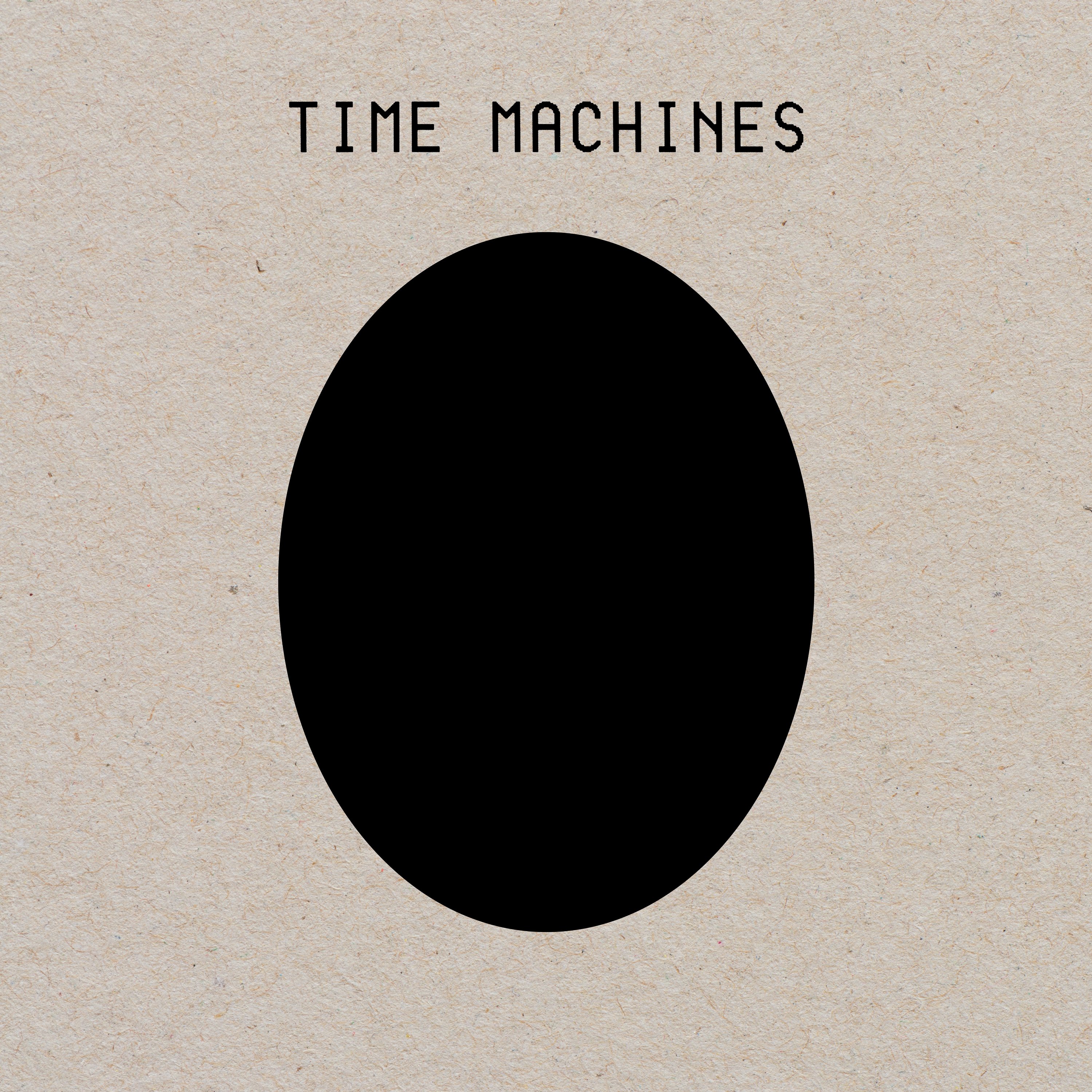
Coil: Time Machines

Julian Mohn: how I imagine the “XYschaton” narrator to look like as a teen

Bob Balaban on Friends: how I imagine the “XYschaton” narrator to look like as an adult

Michael Salerno: Firestarters

Pierre Joubert

Paul Laffoley’s Geochronmechane (1990)

Finn Wolfhard
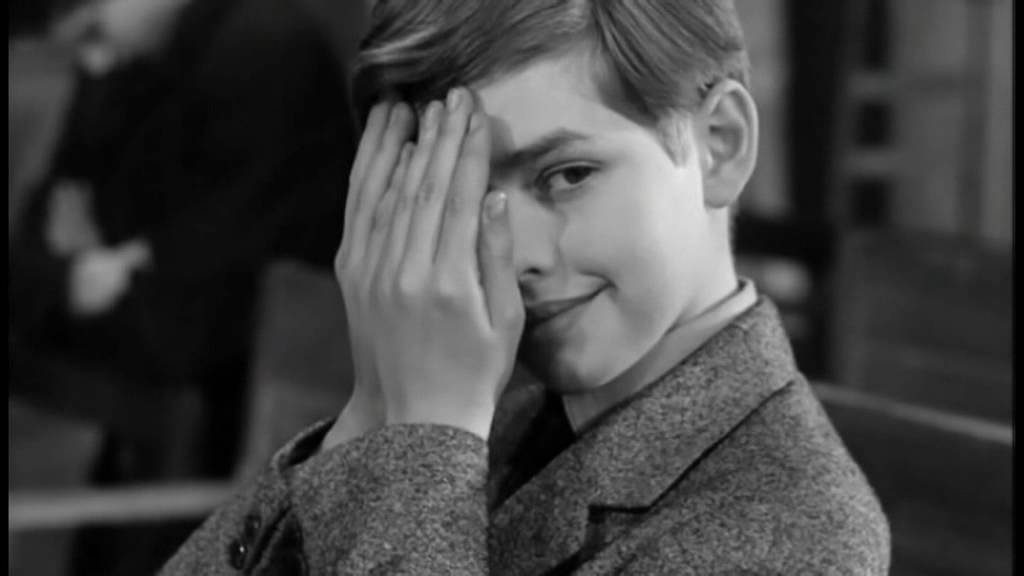
Didier Haudepin
Consumer Electronics: Come Clean
Troye Sivan
David Bowie: Time
Isaac Hempstead-Wright
Fad Gadget: Jump
Diary of a Wimpy Kid 2
Terry Riley: Anthem of the Trinity
William Franklyn-Miller
Cut Hands: Witness the Spread of the Dream
Links of Interest
http://www.snugglybooks.co.uk/
*
p.s. Hey. You guys have a serious feast of a post this weekend, thanks to James ‘Sypha’ Champagne who, on behalf of his fellow Neo-Decadents and himself, kindly chose this blog as the official launch pad/event for an eventful and super lively new anthology starring them and him. (See: above). Please pore and pour over it for the weekend’s duration, speak your minds, ask James questions or tell him what your related personal updrafts involve, etc. Have fun and learn stuff, thank you. And, of course, the giant-est thanks to you, James! ** James Nulick, Ah, the other James, hi! Oh, thanks about my backstories spiel. I think it’s always a good idea to begin by trying to avoid the so-called must-haves of fiction and story telling like back stories, psychological development, the wrap-up, etc., etc. It’s like saying rock songs must have keyboards, bass, and drums. It’s bull. Well, I agree with your take, and, yeah, my stuff doesn’t sell millions either, and thank god. True about the ‘4 books I … ‘ posts. I’ve gotten behind on my reading due to too much work, but I’m putting together one of those posts right now. Mm, no, I don’t believe I’ve ever rehearsed a scene of my fiction in the way you’re describing it. I guess I trust my imagination’s ability to predict or something. Hey, not for me to say, but your dude sounds kind of fuddy-duddy. Maturity and ‘growing up’ and ‘being sensible’ are false flags, if you ask me. But love is love. And, speaking of, love to you! ** David Ehrenstein, Hi, D. Huh, ‘That Summer’ is another film I know nothing about, and the clip you linked to makes me wonder why. Some serious catching up to do. Thank you, sir. ** Steve Erickson, Hi. Well, no, so-called leftists are hardly the only ones responsible, but they should know better. It’s been said often but … take away the age and racial differences and West and Trump are pretty much the same personality. I haven’t been interested in West’s work or schtick from the beginning, and his newest spotlight grab just bores me. I’m curious about that Julien Fargeat film. There are a lot of fascinating seeming documentaries coming out lately, an inordinate amount even. Wow, that Assayas is only now getting a US release? Odd. Everyone, please go read Steve’s review of Olivier Assayas’ 1994 film COLD WATER, which is belatedly and newly in limited release in the US, and which is roundly considered to be one of his very best films. ** Sypha, Hey, maestro! A billion thanks for this weekend’s amazing gift. I hope it helps draw attention to the tome. I will definitely investigate Olga Fröbe-Kapteyn. I don’t know that work at all. It looks really exciting. Thank you! ** Dóra Grőber, Hi, Dóra! ‘Most of what they stand for isn’t even their own, they just never, ever stop and think about it. Never think about “do I even really like this?” or “couldn’t this work some other way?”, etc.’ You put that so well. So strange, isn’t it? I mean it’s a fascinating phenomenon and all, and it seems like social media’s inhaling of people’s lives is largely responsible for that, but, yeah. I always seem to imagine future newsreels or documentaries where mass behavioral distortions like that one are portrayed as weird historical anomalies, and that helps for some reason. You must be well settled into your long, luscious break now. Cool. Oh, yeah, May 1st is a holiday here too. I have to remember to prepare for the closed tobacco shops and markets. We’re still getting the three episodes in shape, which means as we want them to be while trying at the same time to cover our asses by fleshing them out a little as we imagine ARTE will want. Yesterday I finished an initial draft of Episode 1. So 1 & 2 are pretty solid. Now Zac and I will refine those while waiting for our problematic producer to send us her edit of Episode 3 so we can work on that. She was supposed to have sent that to us two weeks ago. Same old. So yesterday was that, and we arranged a meeting for this evening with the guy who wants us to host/curate that club night I mentioned so we can find out if it’s something we actually want to do or not. And today we’re auditioning two back-up dancers for ‘Crowd’ because there are a couple of upcoming gigs where one or more members of the cast can’t do it. Lots to do. Enjoy every molecule of your weekend and please give me the highlights. ** Chris Cochrane, Hi, Chris! What a curious new Robert Gluck project. I don’t know anything about it. Huh. I’m into talking about whatever and anything offline when you like. PGL was a big weirdo in that festival, which was a pretty standard issue queer film festival, but the audience that showed up seemed quite taken and interested. I’ve seen MBV twice back in their heyday. I haven’t seen them since they returned to live action. Should be incredible. Hard to imagine it being anything but that. I send you love too, bud. ** _Black_Acrylic, Hi. Hah, Franz Ferdinand. Their groovy, popular, buzzed-about period sure was a shorty. So exciting about the boxes of books! I’m very excited to see the book, very natch. ** JM, Hi, Hah, thanks a lot, man. Sounds ‘Period’ is doing what I hoped. Have a internally delicious weekend. ** Right. Sypha has given you a veritable literary theme park and free weekend passes, so do indulge yourselves. See you on Monday.




 Now available in North America
Now available in North America 
Hi!
@ Sypha: I just started reading the post but I can already say with much certainty that this is going to be one of my all-time favorites on the blog. Thank you ever so much for gifting us with such a fascinating thing!
It is strange. Depressive and dumbfounding, really. It’s also an interesting thought or fantasy about the future newsreels and documentaries. I’m not sure I can believe that things will get more “real” in the future – real in the sense of people being (re)connected to themselves. I think how we live now is way too comfortable. It’s so much easier to accept pre-set ideas and norms, etc. than to work them out for ourselves. And it’s extremely hard to leave comfort behind. But you know… I’d like to join and think of that fantasy future when I feel too disenchanted.
Despite all the setbacks and the whole unfairness of the situation, you’re making amazing progress with the episodes! I really hope your producer sends you the edit of Episode 3 as soon as… right now. In the meantime: how did the meeting about the club event go? What do they have in mind, exactly? And the ‘Crowd’ audition? Did you manage to find satisfactory back-up dancers? You have quite a busy day today, wow!
Thank you! I finally had the time and energy to sit down and pore through all the SCAB material that arrived this week. And now that I’m finished with that, I’m gonna just cozy up in my bed and read. AND, after quite a long time, tomorrow’s finally free-style day with Anita!
I hope you have a fantastic weekend too, Dennis!
Sypha, A grand day indeed. But quite short by your standards. Are you ill?
Congrats to all of you guys on the publication of the anthology.
I notice you spent quite a lot of time here on the author James Champagne. Do you know him personally?
What is William Frankly Miller going to look like when he’s 40?
All love to you, Sypha, and this epic day. I really like the manifestos. They’re quite great.
Actually, in terms of word count, I believe that my entry is only the 3rd longest. So, nyah-nyah. 😉
I don’t even want to know what William Franklyn-Miller will look like when he’s 25! But at least Tom Holland seems to be aging nicely. 😉
Dennis, I fell asleep hella early last night. Ugh. I think I picked up a bit of a cold from the cat lady at work. Fucking woman was hacking and gagging and sneezing and blowing her nose all week. Though she’s at the other end of the row of cubicles, I think I got a touch of it. Started my zinc treatment right away, so I’m okay, but still…erg.
Only one of the massage places around here has weekend hours. That sucks. So I’m going to wait a couple weeks because I’ve got shit going on this weekend and next. I agreed to go with a friend to see “I Feel Pretty” today, which looks just fucking horrible. This friend of mine, who is very smart, really likes terrible art, whether it’s the Fifty Shades books or something like this movie today. It’s kind of funny but also frustrating to me. I’m doing it because she’s one of my closest friends and I understand her need to escape her life for a bit.
Next weekend, I’m seeing the Avengers movie with another friends. Seems everybody dies in it. That’ll be nice.
Just finished reading Ishiguro’s “The Buried Giant.” It was pretty good. Surprised me, though, that it was a spin-off on the Arthurian legend. But still fun. Next up is “I Am Radar” by Reif Larson, which I bought ages ago and forgot about.
The Gallagher brothers have the same basic personality as West and Trump and spent the 1990s saying things in coked-up interviews like “I hope Blur catch AIDS,” but an awful lot of white rock fans think that was totally cool while they won’t even consider listening to West’s music – which I much prefer to Oasis – because his public persona is so toxic, even though he started out close to Talib Kweli or Common on THE COLLEGE DROPOUT.
As Misa said, given that Sypha did this day, I am amazed it didn’t run to 10,000 words. But there is lots of room for further reading here. The premise of Sypha’s story reminds me of a sci-fi novel I read as a teen in which a scientist invents a time machine, uses it to create alternate versions of himself and then has sex with “himself.” I wish I could recall the author and title.
There are also many shitty documentaries getting made and released in the U.S. Lowering the barriers to entry via cheap, high-quality video cameras, coupled with the fact that American distributors eat up celebrity/artist profiles, are not helping right now. But if I made my 2018 top 10 list now, Travis Wilkerson’s doc DID YOU WONDER WHO FIRED THE GUN? would be #1.
Actually, the final word count was 11,427 words. :p
What you say about that story reminds me that it’s very hard to be original. But even though I’ve never heard of the story of which you speak I do hope that the experimental nature of my story (along with the overarching perviness) would help make them stand apart, ha ha.
On Jay-Z and Kanye West’s song “{N-words} in Paris,” there’s a sample of Will Ferrell saying “No one knows what it means, but it’s provocative…It gets people going.” That might sum up his current approach to self-promotion, except that he’s getting the kind of social media discussion and press that seems likely to deter people from listening to his 2 forthcoming albums instead of buying them.
@Steve Erickson,
The book you’re trying to recall is ‘The Man who Folded Himself’ by David Gerrold
Great stuff, Sypha. While he’s not I believe referenced much of this reminds me of Alfred Jarry’s “Pataphysics.’ I trust you’ve heard o fit.
Yeah, I actually mention Jarry a ton of times in my story (after all, back in the 1890’s Jarry DID write an article on how to construct a time machine, something I make an explicit reference to). And the woodcut that appears right at the start of today’s contributors section was done by Jarry as well.
The Incel subculture seems like something invented from either a Chuck Palahniuk or Michel Houellbecq novel. I feel like the “incels” are in need of a talk that sex is not the be-all and the end-all of life, they might feel lousy and depressed even with a Playmate on their arms, and not being a bitter misogynist makes you more appealing to women, but their rhetoric makes it sound like the end games of their fantasies is stewing to each other on Reddit, not meeting beautiful women and having sex and relationships with them. It says something that I came across a lengthy blog post from a “former incel” who wrote about how fat, unattractive and socially awkward he is, how he didn’t have a girlfriend after a brief period at 17 till 30, and he’s only dating women now because he started going to strip clubs and showering their employees with gifts and money in order to go out with him. As he describes it, the strippers probably can’t stand him but like his money even if this isn’t prostitution in the legal sense, so they’re willing to give him “the girlfriend experience.” He says he’s finally happy. What a fucked up world.
James/ Sypha,
I feel there aren’t enough people named James in the world, or is it just me? ?
I sent you a longish email this morning, but Wow, congrats on the book! I feel there isn’t enough beauty in the world, so any attempt to add a little beauty to this weird holographic rock we live on is alright by me. And I already said this to you in the email, but I would have killed to have written your line ‘every grown man is a walking haunted house…’ Brilliant, sir.
I’ll buy this Snuggly Book once it’s available on Amazon, I’m looking forward to it! I’m already the owner of another Snuggly Book by Justin Isis & Co., the Cutest Girl in Class.
Oh and James, I also like that the book comes with a manifesto… the last good manifesto I read was Scum Manifesto by Valerie Solanas, so you’re in good company! Really though brother, congrats! I’m truly excited for you and for the other contributors ?
Dennis,
You’re right, my other half is a bit old-fashioned, even though he’s 15 years younger than me. But I think I have him coming around on Tao Lin, so we’ll see. Oh, and I bought the hoodie I wanted, false flags be damned! I saw it, I liked it, I bought it! When I’m in Tokyo in October I plan on going to Carhartt to look at jackets and hoodies. The Carhartt in Tokyo is nicer than the one here in Seattle.. hopefully I’ll find some nice street clothing there. My ball and chain wears a suit and tie but I’m just the opposite, such a slob — I dress like a janitor. Or the world’s oldest skater, lol.
Dennis, did you read Supremacist by David Shapiro? If so, what did you think? It’s published on very thick, sumptuous paper by Tyrant Books.
I sincerely hope you get paid next week ????
Love,
James
Thanks for hosting this, Dennis. It is very nice of you.
Many thanks to James for putting this together, and to Dennis for posting.
Dennis thanks again for hosting this…still remember randomly meeting you at Sbarro Pizza in Shibuya (now no longer there), lots happened since then!!
Dennis,
I conducted my little kin·es·the·sia experiment this morning, which consists of a 340lbs morbidly obese woman crawling 36ft on the floor on her hands and knees towards her mother’s bedroom door. We spoke of it the other day — you said you trust your imagination and instincts… but I tend to rely on the physical, perhaps a fault of my own?
I was lying on the sofa (the other half is asleep in bed in the bedroom). I threw the covers off my body and placed my left foot onto the floor. I then crumpled into my foot and rolled onto the floor. I then began the crawl, using my fingernails as pitons and my kneecaps, my elbows, and my toes as a sort-of collective in-tandem pickaxe. I began the crawl from the sofa to the bathroom, which, if I double around and then crawl back to the sofa, is approx 36ft. Please keep in mind that I haven’t crawled on the floor in probably — 46 years? Give or take a year. So I’m a bit rusty.
The toes worked kind of well with my fingers — my pitons — but crawling across the floor on airport-grade Berber carpet is both exhausting and painful, mainly because I’m 48 yo and out of shape.
I’m five foot seven and weigh 165 pounds.. not exactly heart attack country, but more Lulu Roman than Kate Moss. My main girl in the novel, my card player, is 43 yo, five foot eleven, and weighs 340lbs … she may weigh a smidge more, but she’s not telling. The bones in my knees/kneecaps are visible, hers are not, more impressionistic (I have visible divots, she does not).
Per my iPhone stopwatch, It took me 29:15:55 to cross 36ft to the bathroom door, touch the threshold in a relay handoff, then snail back around and head back towards the sofa. As Elizabeth weighs 340lbs — twice my weight — I calculated that it would likely take her twice as long to traverse the floor, even though she has 4 inches on me. So it will basically take her one hour to crawl to her mother’s bedroom door, do her thing, then kneecap it and pivot back around towards her own bedroom, which is at the opposite end of the mobile. Which is what I thought. So, you being the master — I should have listened to you and trusted my instincts! But I did learn a few things —
Common objects take on an uncommonness when viewed 6 inches off the ground.
My partner’s Florsheims have the same smell as their brick and mortar stores did in the 1970s.
My sofa is made in North Carolina (TO BE REMOVED ONLY BY THE CONSUMER)
Surge protectors take on a slightly Satanic look when their red glowing eyes are staring at you, from under the desk, at 5:30 in the morning.
Of course I did all this while under extreme duress, hoping the entire time that the ball and chain would not wake up — he didn’t. I’ve concluded that he can likely sleep through a nuclear holocaust, no problem.
Happy Monday Dennis!
Much love,
James ❤❤
@ Sypha, Neo-Decadence is a movement that looks to have arrived fully formed. Maybe it was gestating for a couple of years but it’s the finished article now, that’s for sure. Back in 2005 I drew some lingerie models in black Biro and called that Olympia in an attempt at something similar maybe. I’m very much digging your musical selections.
This is a big week for Yuck ‘n Yum and I’ll post a few photos as things start to take shape. In the room next door are piles of boxes full of the newly published Compendium, while over in Seattle the SOIL Gallery is being readied for the forthcoming Interregnum show. Everything launches on May 3rd so we’re set for a busy few days.
Congratulations on the new anthology, Sypha. I hope you’re enjoying some of the lifestyle traits on the list! Julian Mohn to Bob Balaban is quite a journey. Will explore more…
Dennis, hope the producer drama has eased off. I’ve just had a week of work drama; I’m trying to focus on the positive, constructive things that did happen. Ah well, it’s practically May! And the new Mike Kitchell is very nice.
Bill
Hey Dennis, thanks again for hosting this day, I (and everyone else with Snuggly Books) greatly appreciate it. And thanks to everyone who took the time to read it through, I hope you enjoy it (and maybe the book as well!).